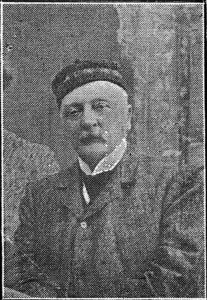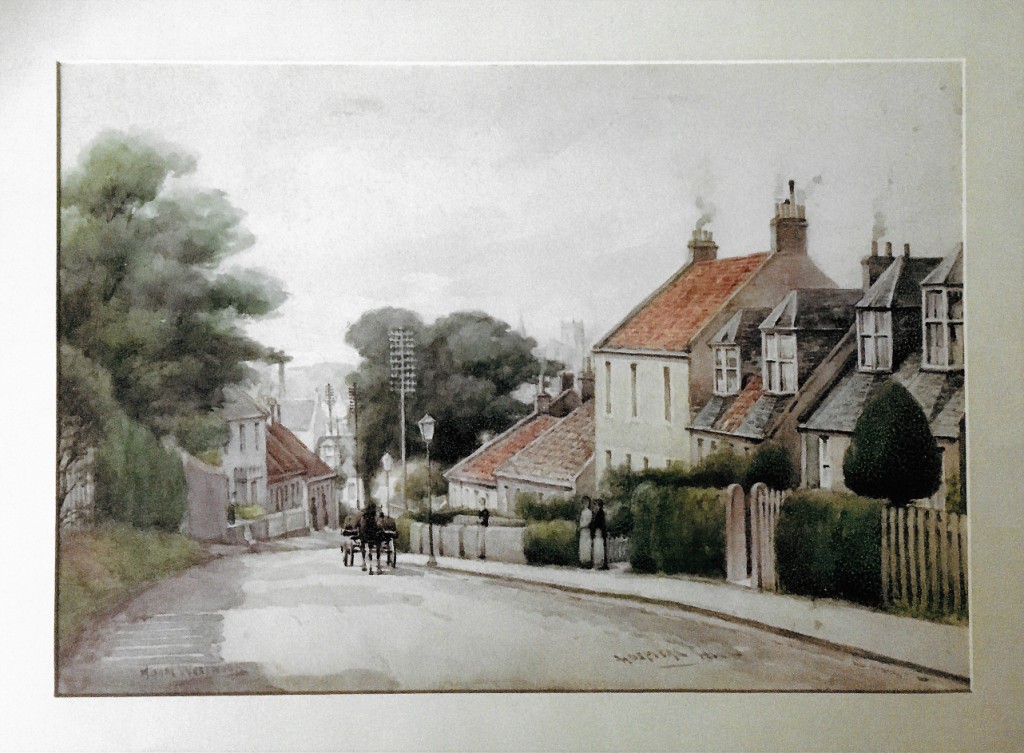ADAM WESTWOOD, DUNFERMLINE ARTIST (1844-1924)
By Dr. Jean Barclay

Adam Westwood was the first child of William Westwood and his wife Isabella Richardson, who both came from old Dunfermline families. William and Isabella were married on June 6th 1842 and Adam was probably born in Guildhall Street in 1844, although no record of his birth or baptism has so far been found. William had been a hand-loom weaver, but shortly after his marriage, when times were hard for weavers, he went to try his luck in New York. He found work in a large store, stayed for about four years and was there to greet the Carnegie family when they arrived in 1848. William returned to Dunfermline shortly afterwards and resumed work as a handloom weaver in the damask weaving shop of Joseph Paton in Damside Street. The census of 1851 shows that William, a hand-loom weaver, Isabella, a straw hat maker, and Adam, a scholar aged seven, were living in Guildhall Street. Adam`s mother, Isabella, an artistic and enterprising woman, used to travel to London to buy hats and other goods and in 1859 opened a showroom at her home to display and sell them. In 1866 William was still a weaver but not long after this was able to set himself up as draper selling the output of Isabella`s skill and other items.
Adam was an only child until July 1857 when his brother John was born, followed in 1859 by his sister Isabella, who sadly died when she was six. Adam was educated at the Free Abbey Academy and, as he showed an artistic bent, it was decided to apprentice him to R. B. Watson, owner of a reputable glass staining firm in the Maygate.
Having finished his apprenticeship at about 17 years of age, Adam obtained employment with the well-known glass staining firm of James Ballantine and Son in Edinburgh, lodging in Carnegie Street, Newington, with John Lennox and his wife Annie who originally hailed from Dunfermline. In his free time, Adam attended the Edinburgh School of Art, where he won several book prizes and medals and in 1865, as a `21-year old glass stainer`, a prize of three guineas for a design for a panel for an upholstery firm and another prize for drawing.
Adam now moved to Glasgow where he obtained a position with W. & J. Kier, glass stainers. In 1870 Adam was 26 and still working with the Kiers when he married Janet Flockhart, a Dunfermline girl. The young couple set up home at 37 Dumbarton Road, Anderston, Glasgow, where three children were born to them, Annie in 1872, William in 1876 and Isabella in 1879.
During the 1870s Adam had a career change when he obtained a position as a journeyman lithographic draughtsman with McClure and Macdonald, a large firm of lithographic printers with a staff of 200. Adam continued with his artistic training at Glasgow School of Art, where he won several medals, notably the International Medal for Design, in a competition open to students throughout Great Britain and Ireland.
During 1879 the family moved to 63 Elmbank Street, near Charing Cross, Glasgow, and it was here in December that Annie sadly died aged 7 years from acute bronchitis. Adam now purchased a four-roomed dwelling house in Sandylands, Limekilns for £40, probably as an investment as it was usually let to two to four tenants.
The 1881 census for Dunfermline shows that Adam`s wife Janet and his children William (5) and Isabella (2) were staying at 19 Guildhall Street with his parents, William, a draper, Isabella, a milliner, his brother John, aged 23, also a draper, and a servant, Christina Beveridge, aged 16. Sadly, John would die from erysipelas when he was a young married man of 26.

by Adam Westwood
Adam is not mentioned in this census and, as biographies state that he pursued his studies successively in London and Paris, meeting several well-known artists of the day, this may be the time when he was on his artistic quest.
In February 1883 back in Elmbank Street, Glasgow, Adam and Janet had another daughter, Christina. While he was still employed Adam exhibited and sold paintings and his future as an artist looked bright but `home duties` now brought him back to Dunfermline and perhaps a more mundane life than he might have had. Adam set himself up as an art teacher and also sold and exhibited paintings in oil and watercolour. His work was well thought of and from 1881 to 1901 nine of his paintings were shown at the Royal Scottish Academy and four at the Royal Glasgow Institute of the Fine Arts.
In 1883 a Fine Arts Association was formed in Dunfermline and the first Fine Arts Exhibition was held at the Carnegie Baths. In 1883 Adam exhibited no fewer than nine paintings there, and in 1886 he exhibited seven, including `The Old Hand Loom`, an oil painting, which was bought for 12 guineas by Henry Campbell-Bannerman the local MP and future prime minister. In the lists of artists for these exhibitions Adam`s address was given both as Albany Cottage and 8 Albany Street in 1883 and 19 Guildhall Street in 1886. By 1885 he was also tenant occupier of a house and garden at 11 Damside Street as well as still owning the cottage at Limekilns.
According to the 1891 census, Adam, Janet and the children lived at 17 Guildhall Street while his parents had retired to Albany Cottage. Like Adam`s mother, his wife and later his daughters Isabella and Christine were milliners, working from home with a showroom next door. By 1896 Adam also had a studio in Carnegie Library Buildings in Abbot Street, where he was joined by his son, William, who was also an artist and art teacher and from about1902 a photographer.
After his father`s death in 1905, Adam and his family moved into Albany Cottage, where his mother died in January1908. In the same year his daughter Isabella went to South Africa to marry a Dunfermline man, William Syme Anderson. Christina kept house for her parents and her brother William until her death aged 40 in1923 from a cerebral tumour. As William died unmarried in 1938, it was only through Isabella and her two children in South Africa that this branch of the Westwoods continued.

by Adam Westwood
All this time, Adam earned money from his teaching, paintings, illustrations for books and pamphlets, and advertising commissions. Nowadays he is probably best known for his homely and colourful paintings of Dunfermline and surrounding villages featuring stylised people and horses and carts of which he was particularly fond, but he also produced precise drawings of churches, schools and other public buildings which reflected his earlier work as a draughtsman. Adam continued to show paintings at various local exhibitions, including from 1902 at the annual Dunfermline Arts and Crafts Exhibitions, which, in keeping with the flavour of the times, included all types of handicraft as well as fine art.
Each week from 1911 until 1916, when news of the Great War began to take over the columns, the Dunfermline Journal and its off-shoot the Dunfermline Express published copies of Adam`s paintings of local scenes and later compiled them into booklets for sale. Although `grainy` and difficult to copy they are a wonderful source for anyone interested in old Dunfermline.
Now began the twilight of Adam Westwood`s life, when the genial old man could be seen all over Dunfermline with his sketchbook or easel `at the centre of a happy and admiring group` amazing his audience with the speed at which he worked to record scenes that were attractive, eventful or about to disappear.
After a gradual decline, Adam died on April 21st 1924 aged 80, Janet following in 1927. It is thanks to Adam Westwood, more than to any other local artist, that we can see something of his native town in bygone days, a Dunfermline we have largely lost.

by Adam Westwood
Notes, acknowledgments and sources:
Notes:
This biography of such a prolific artist begs the question – where are Adam Westwood`s paintings now? A few paintings made their way to South Africa with Isabella Westwood, others were sold to unknown buyers and adorn unknown walls, and there are several still to be found in Dunfermline homes, some of which I have been able to see.
Some 30 paintings can be seen in `Autographs and Sketches` which Adam compiled in 1910 for a friend and was presented to the Carnegie Library in 1964. About 50 reproductions of Westwood paintings appeared in the Dunfermline Journal and Express and in Journal publications like `Views of Old Dunfermline`, Local Art Studies` and the annual Journal Almanac, but the originals are now lost to time.
Acknowledgments:
For help with this article I am grateful to George Robertson for his advice and his generosity with source material, to owners of Westwood paintings, to descendents of the South African Westwood family, and to the staff of the Reading Room at Carnegie Library and Galleries.
Main sources:
Copies of paintings, obituaries and other accounts in the local newspapers;
Westwood`s `Autographs and Sketches` (see above);
`Mr. Adam Westwood: The Artist as Patriot`, the Almanac Supplement to the Dunfermline Journal, 1911-1914;
Directories and dictionaries of Scottish artists;
Scotlandspeople website, valuation rolls & censuses;
Sue Mowat `Shopping for clothes in Victorian Dunfermline`, Dunfermline Historical Society website (for details of Isabella and Janet Westwood);
Dunfermline Art Club catalogues and lists of artists (from Elaine Campbell);
On-line details of Ballantine and Kier glass staining firms and McClure and Macdonald, Lithographic Printers.